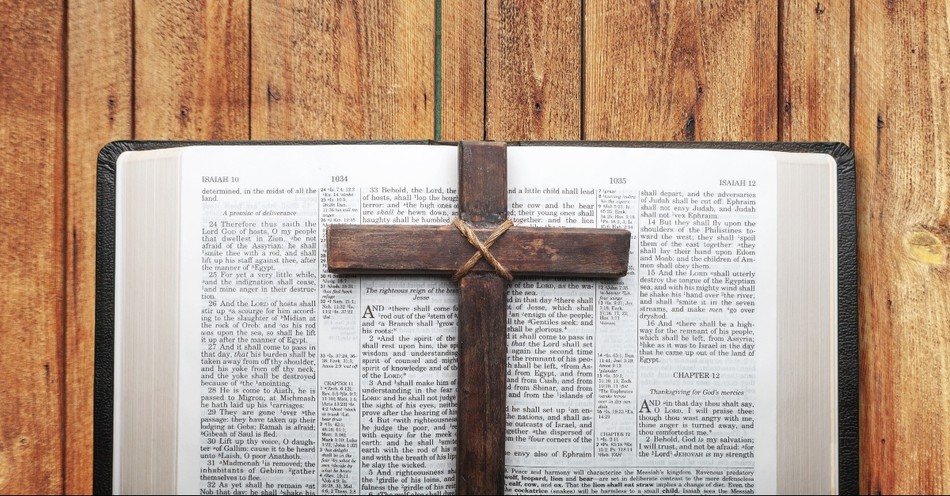“Beginning with Moses and the all the Prophets, he interpreted to them in all the Scriptures the things concerning himself” (Luke 24:27).
Last Christmas, a friend sent me a puzzle. This puzzle came in a plain box with no description or image.
Inside were pieces of various sizes, shapes, and colors, but it was almost impossible to discern any recognizable object. Without any guiding image, I couldn’t tell what I was looking at or how everything fit together.
Old Testament prophecies are like that. The scriptures contain a myriad of verses, statements, and images that point to the coming Messiah. No one knew how these verses fit together, that is, until the resurrection.
The resurrection of Jesus is like the main puzzle piece that interlocks everything and reveals the picture of who God is and what redemption looks like.
This is what Jesus reveals to Cleopas and his companion as they walk along the road to Emmaus. From beginning to end, from A to Z, Jesus helped the disciples understand how the scriptures pointed to him.
Have you ever wondered what scriptures Jesus pointed to? Below are seven Old Testament scriptures that point to Jesus as Savior and Lord.
1. Genesis 3:15
The scriptures open with the familiar story of Adam and Eve. Satan tempts the couple into eating the forbidden fruit, thereby fracturing the sanctity of the garden and their perfect relationship with God.
One of the curious statements that occurs in this account is when God declares to the snake, “I will put enmity between you and the woman, between your seed and hers, He will crush your head and you will strike his heal.”
Here, God describes a future savior. This Savior would be the seed of the woman, born into humanity, and would crush Satan’s dominion over the earth. In doing so, this savior would reverse the fall of the garden.
This victory, however, comes at a cost. God makes clear that the redemption of all things would occur through sacrifice. The savior would be stricken for the redemption of the world. Considering Christ’s death on the cross, this becomes an obvious reference to the cross.
2. Genesis 14:18-20
Following Genesis 3, Jesus may have pointed the disciples to the person of Melchizedek, the mysterious individual who blesses Abraham in Genesis 14. Melchizedek is both a King and a priest of the Most High.
While Melchizedek only shows up for only three verses, his impression is long-lasting. Long before people could ever understand the significance, Melchizedek blessed Abraham with a meal of bread and wine. Did Jesus point to this meal as a foretaste of the Last Supper?
Melchizedek offers a unique picture of Jesus, who is both King of Kings and Great High Priest (Hebrews 4:14).
Furthermore, while the people of Israel may not have understood any significance to Melchizedek’s meal, in the light of Jesus, this offering takes on new meaning. The offering of bread and wine points to the sacred meal offered by Christ.
3. Numbers 21:4-9
Beyond mere references to the future redeemer, the Old Testament scriptures also speak to Christ’s death on the cross. Perhaps the biggest example of this is found in the Book of Numbers.
In Numbers 21, we read the story of Moses erecting a bronze snake on a pole. The bronze snake becomes a symbol of life and salvation.
What is particularly important about this story is the fact that the symbol of cursing and death becomes a symbol of life and restoration.
The very means of punishment and cursing (i.e., being bitten by the snake), becomes the very means of redemption. This undoubtedly echoes what occurs on the cross.
The connection to the cross, however, is not simply in the physical structure that may have been erected. Like poisonous snakes to Israel, the cross represented divine abandonment. The person hanging on the cross was seen to be under God’s curse.
4. Deuteronomy 21:23
Numbers 21 goes back to Deuteronomy 21:23, which says, “Cursed is anyone who is hung on a tree.” Thus, when Jesus hung on the cross, he was seen to be suffering the under the full weight of a divine curse.
And yet, through the resurrection, the cross is transformed into the means of redemption. It is through the cross that Jesus obtains salvation, and it is by looking to the cross that we enter eternal life.
5. Leviticus 23:5-8
Anyone familiar with the Old Testament scriptures will know that Israel’s entire sacrificial system was centered around the sacrifice of the paschal lamb.
What began the Exodus journey became ritualized in the Temple as the Day of Atonement. Once a year, a lamb, without spot or blemish, would be slain for the sins of the people.
In a similar fashion, Jesus is crucified for the sins of the world. This is one of the reasons why John the Baptist refers to Jesus as the “lamb of God who takes away the sin of the world” (John 1:29).
In fact, the Gospel of John makes clear that the crucifixion happened at the very same time that the Passover lamb was being slain in the temple. The sacrifice of the paschal lamb throughout the years, therefore, served to point to the ultimate sacrifice that would occur on the cross.
6. Daniel 3:25
When we move into the prophets, the scriptures reveal Jesus as the Christ. One of the enduring stories is the tale of Shadrach Meshach and Abednego. The story is a favorite for picture Bibles and Sunday School lessons.
In Daniel 3, the story returns to Hebrew sons, who, along with Daniel, were taken into Babylonian captivity. Despite surmounting opposition, they remain faithful to God and defy King Nebuchadnezzar’s command to worship his golden statue.
Because of this, they are condemned to death by being burned in a fiery furnace. Miraculously, the three are saved. Yet more miraculously is the fact that the king views a fourth individual whom he describes as “like a son of the gods.”
The original readers of the text might never have concluded that the fourth individual in that furnace referred to the “Son of God,” the second person of the divine Trinity.
Yet that is what is revealed in the resurrection of Jesus. Because Jesus is known as “the Son of God,” we can proclaim his presence in the fiery furnace.
7. Isaiah 53
The suffering servant passages of Isaiah are well known. Isaiah 53 particularly stands out above the others, given its description that the Savior of the world would be pierced for our transgressions and crushed for our iniquities.
This is an obvious reference to the crucifixion. That same chapter, however, also speaks of the resurrection.
Verse 11 says, “After the suffering of his soul, he will see the light of life, and be satisfied, and by his knowledge, my righteous servant will justify many and he will bear their iniquities.”
This prophecy pictures the messiah, dying for our transgressions, having his hands and his feet pierced, but then rising again to new life to justify and save the world.
What Does This Mean?
Many more scriptures could be referenced. There are verses that speak about where the Messiah would be born, what lineage he would be from, and where the Messiah would grow up. Prophets spoke of the Messiah, opening the eyes of the blind, healing the sick, and raising the dead.
In fact, scholars have calculated that the probability of one person fulfilling just eight of the messianic prophecies of scripture is 1 in 10 to the 17th power. But Jesus didn’t just fulfill eight prophecies; he fulfilled over 300 of them, many of which occurred beyond his control.
In the end, the resurrection isn’t a dream or a fanciful wish. The resurrection is the culmination of all that God had been doing and saying throughout the ages.
When we look at the whole movement of Scripture, we see one unified story revealing Jesus to be the fulfillment of all God’s redemptive plan. It was this fulfillment that caused the disciples to proclaim the Lordship of Jesus.
For further reading:
What Are the Prophecies about Jesus?
What Old Testament Prophecies Predicted Jesus and the Cross?
How Can I Identify Messianic Prophecies in the Old Testament?
Photo Credit: ©iStock/Getty Images Plus/artisteer




.jpg)
